
‘Tis the season for red and green, and as many families look to bring holiday cheer into their homes, the poinsettia is the Christmas plant of choice. The poinsettia has long been a mainstay in festive decor, but its popularity extends back farther than you might think. In fact, while the traditional poinsettia has crimson leaves, there are more than 100 different varieties of the plant. Some are bright white, and others boast a beautiful range of blush pinks and dramatic burgundies. In fact, the leaves don’t have to be one color. Some may have speckles or edges of different hues on their leaves, or even an awe-inspiring marbled print. So where did these majestic plants come from?
An Aztec origin
The poinsettia shrub is native to the hot, dry areas of Mexico and Central America, where it can flourish and grow to reach up to 10 to 15 feet tall. Before the plant even came to the U.S., it had a long cultivation history with the Aztecs. According to the University of Illinois, the natives used the bracts, or leaves of the “cuetlaxochitl” to make a red dye between the 14th and 16th century. Additionally, the sap was used as a medicinal treatment to control fevers. Since the poinsettia plant could not grow in the high altitude of Mexico City, Montezuma, the last Aztec king, had it brought from other regions. Later, Franciscan priests incorporated the plant into the Fiesta of Santa Pesebre nativity procession around the 17th century. It seemed only natural to make the poinsettia a part of Christmas as it naturally flowered during that season.
Send a gift of a poinsettia plant this Christmas

An American tradition
This festive plant was finally introduced into the U.S. by Joel Roberts Poinsett, a botanist and the first American ambassador to Mexico, in 1825. After being appointed ambassador by President John Quincy Adams, he was sent to Mexico during one of the country’s civil wars. With a passion for botany, he decided to introduce the American elm into Mexico. Meanwhile, a stunning shrub caught his eye by the side of a road. He was so captivated by the radiant red leaves that he brought cutting back from his trip to his plantation in Greenwood, S.C.
According to the NC State University College of Agriculture & Life Sciences, Albert Ecke is largely responsible for the breeding of poinsettias in the U.S. He started a cut flower farm in Hollywood and after moving it to Encinitas, Calif., he began to focus solely on growing poinsettia mother plants. How did the shrubs get there, though, if they weren’t native to California? Railroad box cars carried them from Mexico. Eventually the Eckes grew poinsettias in greenhouses, and this family is now recognized as the leading producer of this plant in the entire country. The German Fischer family also made significant strides in the poinsettia tradition. This family contributed programs for the plant that emphasized stronger stems, multiple branching, earlier blooming, color variation and other breeding aspects.
While we know the plant as the poinsettia, its botanical name is euphorbia pulcherrima. The University of Illinois noted that the German botanist Wilenow gave the plant this name when he observed it growing through a crack in his greenhouse – and it fits – the meaning is “very beautiful.”
Today, the poinsettia is an important part of the holiday spirit, and the tradition shows no sign of slowing down. It took some time for this joyful plant to reach such a high level of popularity and appreciation, but now it has become our favorite decoration of the season.





